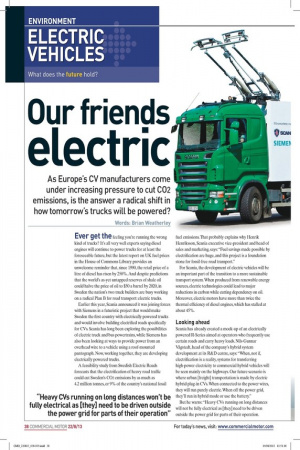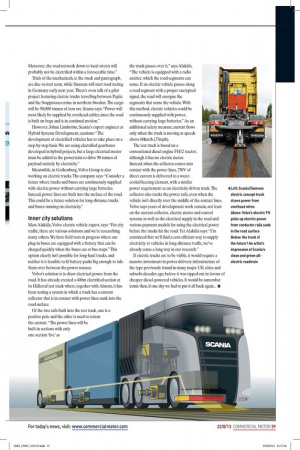Our friends
Page 30

Page 31

If you've noticed an error in this article please click here to report it so we can fix it.
electric
As Europe's CV manufacturers come
under increasing pressure to cut CO2 emissions, is the answer a radical shift in how tomorrow's trucks will be powered?
Ever get the feeling you're running the wrong kind of trucks? It's all very well experts saying diesel engines will continue to power trucks for at least the foreseeable future, but the latest report on UK fuel prices in the House of Commons Library provides an unwelcome reminder that, since 1990, the retail price of a litre of diesel has risen by 250%. And despite predictions that the world's as-yet untapped reserves of shale oil could halve the price of oil to $50 a barrel by 2020, in Sweden the nation's two truck builders are busy working on a radical Plan B for road transport: electric trucks.
Earlier this year, Scania announced it was joining forces with Siemens in a futuristic project that would make Sweden the first country with electrically powered trucks and would involve building electrified roads specifically for CVs. Scania has long been exploring the possibilities of electric truck and bus powertrains, while Siemens has also been looking at ways to provide power from an overhead wire to a vehicle using a roof-mounted pantograph. No working together, they are developing electrically powered trucks. A feasibility study from Swedish Electric Roads forecasts that the electrification of heavy road traffic could cut Sweden's CO2 emissions by as much as 4.2 million tonnes, or 9% of the country's national fossil
fuel emissions. That probably explains why Henrik Henriksson, Scania executive vice-president and head of sales and marketing, says: "Fuel savings made possible by electrification are huge, and this project is a foundation stone for fossil-free road transport."
For Scania, the development of electric vehicles will be an important part of the transition to a more sustainable transport system. When produced from renewable energy sources, electric technologies could lead to major reductions in carbon while cutting dependency on oil. Moreover, electric motors have more than twice the thermal efficiency of diesel engines, which has stalled at about 45%.
Looking ahead
Looking ahead
Scania has already created a mock-up of an electrically powered R-Series aimed at operators who frequently use certain roads and carry heavy loads. Nils-Gunnar Vagstedt, head of the company's hybrid system development at its R&D centre, says: "When, not if, electrification is a reality, systems for transferring high-power electricity to commercial hybrid vehicles will be seen mainly on the highways. Our future scenario is where urban [freight] transportation is made by electric hybrid plug-in CVs. When connected to the power wires, they will run purely electric. When off the power grid, they'll run in hybrid mode or use the battery."
But he warns: "Heavy CVs running on long distances will not be fully electrical as [they] need to be driven outside the power grid for parts of their operation.
Moreover, the road network down to local streets will probably not be electrified within a foreseeable time."
Trials of the mechanicals, ie the truck and pantograph, are due to start soon, while Siemens will start road testing in Germany early next year. There's even talk of a pilot project featuring electric trucks travelling between Pajala and the Svappavaara mine in northern Sweden. The cargo will be 90,000 tonnes of iron ore. Scania says: "Power will most likely be supplied by overhead cables, since the road is built on bogs and is in continual motion."
However, Johan Lindstrom, Scania's expert engineer at Hybrid Systems Development, cautions: "The development of electrified vehicles has to take place on a step-by-step basis. We are using electrified gearboxes developed in hybrid projects, but a large electrical motor must be added to the powertrain to drive 90 tonnes of payload entirely by electricity."
Meanwhile, in Gothenburg, Volvo Group is also working on electric trucks. The company says: "Consider a future where trucks and buses are continuously supplied with electric power without carrying large batteries. Instead, power lines are built into the surface of the road. This could be a future solution for long-distance trucks and buses running on electricity."
Inner city solutions
Mats Alaktila,Volvo electric vehicle expert, says: "For city traffic, there are various solutions and we're researching many others. We have field tests in progress where our plug-in buses are equipped with a battery that can be charged quickly when the buses are at bus stops." This option clearly isn't possible for long-haul trucks, and neither is it feasible to fit battery packs big enough to tide them over between the power sources.
Volvo's solution is to draw electrical power from the road. It has already created a 400m electrified section at its Haltered test track where, together with Alstom, it has been testing a system in which a truck has a current collector that is in contact with power lines sunk into the road surface. Of the two rails built into the test track, one is a positive pole and the other is used to return the current. "The power lines will be built in sections with only one section 'live' as Of the two rails built into the test track, one is a positive pole and the other is used to return the current. "The power lines will be built in sections with only one section 'live' as Of the two rails built into the test track, one is a positive pole and the other is used to return the current. "The power lines will be built in sections with only one section 'live' as
the truck passes over it," says Alaktila. "The vehicle is equipped with a radio emitter, which the road segments can sense. If an electric vehicle passes along a road segment with a proper encrypted signal, the road will energise the segments that sense the vehicle. With this method, electric vehicles could be continuously supplied with power, without carrying large batteries." As an additional safety measure, current flows only when the truck is moving at speeds above 60km/h (37mph).
The test truck is based on a conventional diesel engine FH12 tractor, although it has no electric motor. Instead, when the collector comes into contact with the power lines, 750V of direct current is delivered to a watercooled heating element, with a similar power requirement as an electricity-driven truck. The collector also tracks the power rails, even when the vehicle isn't directly over the middle of the contact lines. Volvo says years of development work remain, not least on the current collector, electric motor and control systems as well as the electrical supply in the road and various payment models for using the electrical power before the trucks hit the road. Yet Alaktila says: "I'm convinced that we'll find a cost-efficient way to supply electricity to vehicles in long-distance traffic, we've already come a long way in our research."
The test truck is based on a conventional diesel engine FH12 tractor, although it has no electric motor. Instead, when the collector comes into contact with the power lines, 750V of direct current is delivered to a watercooled heating element, with a similar power requirement as an electricity-driven truck. The collector also tracks the power rails, even when the vehicle isn't directly over the middle of the contact lines. Volvo says years of development work remain, not least on the current collector, electric motor and control systems as well as the electrical supply in the road and various payment models for using the electrical power before the trucks hit the road. Yet Alaktila says: "I'm convinced that we'll find a cost-efficient way to supply electricity to vehicles in long-distance traffic, we've already come a long way in our research." If electric trucks are to be viable, it would require a massive investment in power-delivery infrastructure of the type previously found in many major UK cities and suburbs decades ago, before it was ripped out in favour of cheaper diesel-powered vehicles. It would be somewhat ironic then, if one day we had to put it all back again... •









































